|
Racial policy of Nazi Germany
The racial policy of Nazi Germany was a set of policies and laws implemented in Nazi Germany under the dictatorship of Adolf Hitler, based on pseudoscientific and racist doctrines asserting the superiority of the putative "Aryan race", which claimed scientific legitimacy. This was combined with a eugenics program that aimed for "racial hygiene" by compulsory sterilization and extermination of those who they saw as Untermenschen ("sub-humans"), which culminated in the Holocaust. Nazi policies labeled centuries-long residents in German territory who were not ethnic Germans such as Jews (which in Nazi racial theory were emphasized as a Semitic people of Levantine origins), Romani (an Indo-Aryan people originating from the Indian subcontinent, historically colloquially referred to derogatorily as "Gypsies"), along with the vast majority of Slavs (mainly ethnic Poles, Serbs, Ukrainians, Russians, Belarusians, etc.), and most non-Europeans as inferior non-Aryan subhumans (under the Nazi appropriation of the term "Aryan") in a racial hierarchy that placed the Herrenvolk ("master race") of the Volksgemeinschaft ("people's community") at the top.[1][2][3][4] The racial policy of the Nazi Party and the German state was organized through the Office of Racial Policy, which published circulars and directives to relevant administrative organs, newspapers, and educational institutes.[5] Historical origins of Nazi racial theories and policiesAdolf Hitler himself along with other members of the Nazi Party in the Weimar Republic (1918–1933) were greatly influenced by several 19th- and early 20th-century thinkers and proponents of philosophical, onto-epistemic, and theoretical perspectives on ecological anthropology, scientific racism, holistic science, and organicism regarding the constitution of complex systems and the theorization of organic-racial societies.[6][7][8][9] In particular, one of the most significant ideological influences on the Nazis was the 19th-century German nationalist philosopher Johann Gottlieb Fichte, whose works had served as an inspiration to Hitler and other Nazi Party members, and whose ideas were implemented among the philosophical and ideological foundations of Nazi-oriented Völkisch nationalism.[7] Influences and inspirations from American racismNazi racial policies were in many ways directly influenced by the United States. The Nazis used "American Models" of racism to oppress and subjugate racial minorities as referenced by James Q. Whitman, author of Hitler's American Model and Professor at Yale University, who stated in his book "In the 1930s, Nazi Germany and the American South had the appearance, in the words of two southern historians[who?], of a "mirror image": these were two unapologetically racist regimes, unmatched in their pitilessness."[10] Jim Crow Era laws were a key inspiration for Adolf Hitler and the Nazi party, as the Nazis mirrored their form of racial oppression and segregation in the model of Jim Crow and segregation policy of the United States.[11] Nevertheless, the model of oppression and subjugation directly modeled what the Nazis would implement to oppress racial minorities that did not make up the Aryan composite. Banning from civil service, segregation, barring marriage between Aryans and non-Aryans, as well as the expulsion of Jewish people and other "undesirables" from government, military, and other essential positions,[12] were the most essential aspects of the Nuremberg Laws of 1935 and were directly modeled by what had been done to Black Americans during Jim Crow.[10] Arguably, the most influential of American policies can be seen in "Lebensraum," or an expansion of land exclusively for German Aryans, which saw the expulsion, murder, and enslavement of Jewish people, Slavic peoples, and other races deemed inferior.[13] Basis of Nazi policies and the constitution of the Aryan Master Race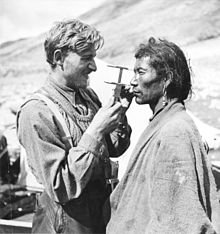 The Aryan master race conceived by Adolf Hitler and the other Nazis graded humans on a scale of pure Aryans to non-Aryans (who were viewed as subhumans).[14] At the top of the scale of pure Aryans were Nordic-type Germans and other Nordic-Aryan Germanic and Northern European peoples, including the Dutch, Scandinavians, and the English.[14] Latins were held to be somewhat inferior, but were tolerated; and the French were thought to have a suitable admixture of Germanic blood.[15] The feeling that Germans were the Aryan Herrenvolk (Aryan master race) was widely spread among the German public through Nazi propaganda and among Nazi officials throughout the ranks, in particular when the Reichskommissar of Ukraine Erich Koch said:
The Nazis considered the Slavs as Non-Aryan Untermenschen ("sub-humans") who were to be enslaved and exterminated by Germans.[4] Slavic nations such as the Ukrainians, Czechs, Slovaks, Bulgarians and Croats who collaborated with Nazi Germany were still being perceived as not racially "pure" enough to reach the status of Germanic peoples, yet they were eventually considered ethnically better than the rest of the Slavs, mostly due to pseudoscientific theories about these nations having a considerable admixture of Germanic blood.[17] In countries where these people lived, there were according to Nazis small groups of non-Slavic German descendants. These people underwent a "racial selection" process to determine whether or not they were "racially valuable", if the individual passed they would be re-Germanised and forcefully taken from their families in order to be raised as Germans.[18][19][20] This secret plan Generalplan Ost ("Master Plan East") aimed at expulsion, enslavement and extermination of most Slavic people. Nazi policy towards them changed during World War II as a pragmatic means to resolve military manpower shortages: they were allowed, with certain restrictions, to serve in the Waffen-SS, in spite of being considered subhumans.[20] Nazi propaganda portrayed people in Eastern Europe with an Asiatic appearance to be the result of intermingling between the native Slavic populations and Asiatic or Mongolian races as sub-humans dominated by the Jews with the help of Bolshevism.[21] At the bottom of the racial scale of non-Aryans were Jews, ethnic Poles, ethnic Serbs and other Slavic people, Romani, and black people.[22] The Nazis originally sought to rid the German state of Jews and Romani by means of deportation (and later extermination), while black people were to be segregated and eventually eliminated through compulsory sterilization.[22][23] Volkisch theorists believed that Germany's Teutonic ancestors had spread out from Germany throughout Europe.[24] Of the Germanic tribes that spread through Europe, the theorists identified that the Burgundians, Franks, and Western Goths joined with the Gauls to make France; the Lombards moved south and joined with the Italians; the Jutes made Denmark; the Angles and Saxons made England; the Flemings made Belgium; and other tribes made the Netherlands.[24] Nazi racial beliefs of the superiority of an Aryan master race arose from earlier proponents of a supremacist conception of race such as the French novelist and diplomat Arthur de Gobineau, who published a four-volume work titled An Essay on the Inequality of the Human Races (translated into German in 1897).[25] Gobineau proposed that the Aryan race was superior, and urged the preservation of its cultural and racial purity.[26] Gobineau later came to use and reserve the term Aryan only for the "German race" and described the Aryans as 'la race germanique'.[27] By doing so he presented a racist theory in which Aryans—that is Germans—were all that was positive.[28] Houston Stewart Chamberlain's work The Foundations of the Nineteenth Century (1900), one of the first to combine Social Darwinism with antisemitism, describes history as a struggle for survival between the Germanic peoples and the Jews, whom he characterized as an inferior and dangerous group.[29] The two-volume book Foundations of Human Hereditary Teaching and Racial Hygiene (1920–21) by Eugen Fischer, Erwin Baur, and Fritz Lenz, used pseudoscientific studies to conclude that the Germans were superior to the Jews intellectually and physically, and recommended eugenics as a solution.[30] Madison Grant's work The Passing of the Great Race (1916) advocated Nordicism and proposed using a eugenic program to preserve the Nordic race. After reading the book, Hitler called it "my Bible".[31] Racist author and Nordic supremacist[32] Hans F. K. Günther, who influenced Nazi ideology, wrote in his "Race Lore of German People" (Rassenkunde des deutschen Volkes) about the danger of "Slavic blood of Eastern race" mixing with the German[33] and combined virulent nationalism with Antisemitism.[34] Günther became an epitome of corrupt and politicized pseudo-science in post-war Germany.[35] Among the topics of his research were attempts to prove that Jews had an unpleasant "hereditary smell".[36] While one of the most prominent Nazi writers, Günther still was not considered the most "cutting edge" by Nazis.[37] 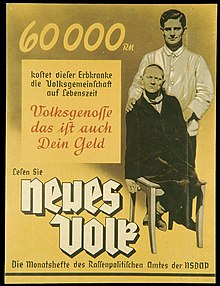 The July 1933 Law for the Prevention of Hereditarily Diseased Offspring—written by Ernst Rüdin and other theorists of "racial hygiene"—established "Genetic Health Courts" which decided on compulsory sterilization of "any person suffering from a hereditary disease." These included, for the Nazis, those suffering from "Congenital Mental Deficiency", schizophrenia, "Manic-Depressive Insanity", "Hereditary Epilepsy", "Hereditary Chorea" (Huntington's), Hereditary Blindness, Hereditary Deafness, "any severe hereditary deformity", as well as "any person suffering from severe alcoholism".[38] Further modifications of the law enforced sterilization of the "Rhineland bastards" (children of mixed German and African parentage). The Nazi Party wanted to increase birthrates of those who were classified as racially elite. When the Party gained power in 1933, one of their first actions was to pass the Law for the Encouragement of Marriage. This law stated that all newly married couples of the Aryan race could receive a government loan. This loan was not simply paid back, rather a portion of it would be forgiven after the birth of each child. The purpose of this law was very clear and simple: to encourage newlyweds to have as many children as they could, so that the Aryan population would grow.[39] Racial policies regarding the Jews, 1933–1939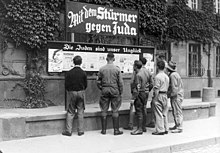 Approximately 525,000 Jews were living in Germany in 1933 (0.75% of the entire German population).[40] Discrimination against Jews began immediately after the national seizure of power in 1933.[41] The Nazi Party used populist antisemitic views to gain votes. Using the "stab-in-the-back legend", they blamed poverty, the hyperinflation in the Weimar Republic, unemployment, and the loss of World War I and surrender by the "November Criminals" all on the Jews and "cultural Bolsheviks", the latter considered to be in a conspiracy with the Jews. German woes were attributed to the effects of the Treaty of Versailles. In 1933, persecution of the Jews became active Nazi policy. This was at first hindered by the lack of agreement on who qualified as a Jew as opposed to an Aryan; this caused legislators to balk at an antisemitic law for its ill-defined terms.[42] Bernhard Lösener described it as "total chaos", with local authorities regarding anything from full Jewish background to 1⁄8 Jewish blood as defining a Jew; Achim Gercke urged 1⁄16 Jewish blood.[43] Those of mixed descent (Mischlinge) were especially problematic in their eyes.[44] The first antisemitic law was promulgated with no clear definition of a Jew.[45] Finally, the criterion was set at three or four Jewish grandparents; two or one rendered a person a Mischling.[46] On April 1, 1933, the Nazi boycott of Jewish businesses was observed throughout Germany. Only six days later, the Law for the Restoration of the Professional Civil Service was passed, banning Jews from government jobs. It is notable that the proponents of this law, and the several thousand more that were to follow, most frequently explained them as necessary to prevent the infiltration of damaging, "alien-type" (Artfremd) hereditary traits into the German national or racial community (Volksgemeinschaft).[47] These laws meant that Jews were now indirectly and directly dissuaded or banned from privileged and superior positions reserved for "Aryan Germans". From then on, Jews were forced to work in more menial positions, becoming second-class citizens or to the point that they were "illegally residing" in Nazi Germany. In the early years of Nazi rule, there were efforts to secure the elimination of Jews by expulsion; later, a more explicit commitment was made to extermination. On August 25, 1933, the Nazis signed the Haavara Agreement with Zionists to allow German Jews to emigrate to Palestine in exchange for a portion of their economic assets. The agreement offered a way to leave an increasingly hostile environment in Nazi Germany; by 1939, 60,000 German Jews (about 10% of the Jewish population) had emigrated there. Thereafter, Nazi policy eventually changed to one of total extermination. Nazi doctrine culminated in the Holocaust, or so-called "Final Solution", which was made official at the January 1942 Wannsee Conference. Nuremberg Laws
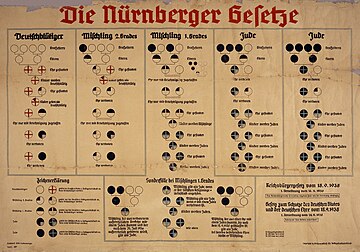 Between 1935 and 1936, persecution of the Jews increased apace while the process of "Gleichschaltung" (lit.: "standardisation", the process by which the Nazis achieved complete control over German society) was implemented. In May 1935, Jews were forbidden to join the Wehrmacht (the armed forces), and in the summer of the same year, anti-Semitic propaganda appeared in shops and restaurants. The Nuremberg Laws were passed around the time of the great Nazi rallies at Nuremberg; on September 15, 1935, the "Law for the Protection of German Blood and Honor" was passed. At first this criminalised sexual relations and marriage only between Germans and Jews,[48] but later the law was extended to "Gypsies, Negroes and their bastard offspring"; it became punishable by law as Rassenschande or racial pollution.[49][50] After this, the "Reich Citizenship Law" was passed, and was reinforced in November by a decree; it included only people of "German or related blood", which meant that all Jews were stripped of their citizenship and their official title became "subjects of the state". This meant that they were deprived of basic citizens' rights, e.g. the right to vote.[51] This removal of citizens' rights was instrumental in the process of anti-semitic persecution: the process of denaturalization allowed the Nazis to exclude—de jure—Jews from the "Volksgemeinschaft" ("national community"), thus granting judicial legitimacy to their persecution and opening the way to harsher laws and, eventually, extermination of the Jews. Philosopher Hannah Arendt pointed out this important judicial aspect of the Holocaust in The Origins of Totalitarianism (1951), where she demonstrated that to violate human rights, Nazi Germany first deprived human beings of their citizenship. Arendt underlined that in the Declaration of the Rights of Man and of the Citizen, citizens' rights actually preceded human rights, as the latter needed the protection of a determinate state to be actually respected. The drafting of the Nuremberg Laws has often been attributed to Hans Globke. Globke co-authored several aspects of the laws, such as the ordinance which legally required Jews with non-Jewish names to take on the additional first names Israel or Sara, along with the official legal commentary on the Reich Citizenship Law.[51] 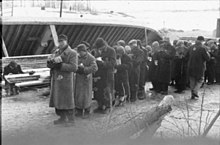 In 1936, Jews were banned from all professional jobs, effectively preventing them from having any influence in education, politics, higher education, and industry. There was now nothing to stop the anti-Jewish actions that spread across the German economy. Between 1937 and 1938, new laws were implemented, and the segregation of Jews from the "German Aryan" population was completed. In particular, Jews were punished financially for being Jewish. From March 1, 1938, government contracts could not be awarded to Jewish businesses. On September 30, "Aryan" doctors could only treat "Aryan" patients. Provision of medical care to Jews was already hampered because Jews were banned from being doctors. On August 17, Jews with first names of non-Jewish origin were legally required to add "Israel" (males) or "Sara" (females) to their names, and a large letter "J" was to be printed on their passports on October 5.[51] On November 15, Jewish children were banned from going to state-run schools. By April 1939, nearly all Jewish companies had either collapsed under financial pressure and declining profits, or been persuaded to sell out to the government, further reducing their rights as human beings; they were, in many ways, effectively separated from the German populace. The increasingly totalitarian regime that Hitler imposed on Germany allowed him to control the actions of the military. On November 7, 1938, a young Polish Jew named Herschel Grynszpan attacked and shot German diplomat Ernst vom Rath in the German embassy in Paris. Grynszpan's family, together with more than 12,000 Polish-born Jews, had been expelled by the Nazi government from Germany to Poland in the so-called "Polenaktion" on October 28, 1938. Joseph Goebbels ordered retaliation. On the night of November 9, the SS and SA conducted "the Night of Broken Glass" ("Kristallnacht"), in which at least 91 Jews were killed and a further 30,000 arrested and incarcerated in Nazi concentration camps. After the start of the war, and the conquest of numerous European countries, the Jewish population was put into ghettos, from which they were shipped to death camps where they were murdered. Jewish responses to the Nuremberg Laws After the promulgation of the Nuremberg Laws, the Reichsvertretung der Deutschen Juden (Representation of the German Jews) announced the following:
Sinti and Roma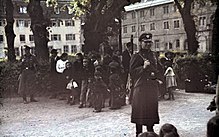 Nazi Germany began persecution of the Romani as early as 1936 when they began to transfer the people to municipal internment camps on the outskirts of cities, a prelude to the deportation of 23,000 Gypsies to concentration camps. "Pure-blooded" Gypsies were considered by the Nazis to be Aryan.[53] Roughly ten percent of Gypsies were considered to be racially pure.[54] Heinrich Himmler suggested creating a "Gypsy Law" to separate Gypsies from the German people:
However, although many laws during Nazi Germany persecuted the Gypsies, a specific "Gypsy Law", although talked about often, was never enacted by the Nazis.[56] Afro-Germans In Mein Kampf, Hitler described children resulting from marriages to African occupation soldiers as a contamination of the Aryan race "by Negro blood on the Rhine in the heart of Europe."[57] He thought that "Jews were responsible for bringing Negroes into the Rhineland, with the ultimate idea of bastardizing the white race which they hate and thus lowering its cultural and political level so that the Jew might dominate."[58] He also implied that this was a plot on the part of the French, saying the population of France was being increasingly "negrified".[59][60]  The number of black people in Germany when the Nazis came to power is variously estimated at 5,000 to 25,000.[59][61] According to the United States Holocaust Memorial Museum, Washington, D.C., "The fate of black people from 1933 to 1945 in Nazi Germany and in German-occupied territories ranged from isolation to persecution, sterilization, medical experimentation, incarceration, brutality, and murder. However, there was no systematic program for their elimination as there was for Jews and other groups."[59] Prior to Hitler coming to power, black entertainers were popular in Germany, but the Nazis banned jazz as "corrupt negro music".[59] Of particular concern to the Nazi scientist Eugen Fischer were the "Rhineland Bastards": mixed-race offspring of Senegalese soldiers who had been stationed in the Rhineland as part of the French army of occupation. He believed that these people should be sterilized in order to protect the racial purity of the German population. At least 400 mixed-race children were forcibly sterilized in the Rhineland by 1938. This order only applied in the Rhineland. Other African Germans were unaffected. Despite this policy, there was never any systematic attempt to eliminate the black population in Germany, though some black people were used in medical experiments, and others mysteriously disappeared.[59] According to Susan Samples, the Nazis went to great lengths to conceal their sterilization and abortion program in the Rhineland.[62] Hans Massaquoi describes his experience as a half-African in Hamburg, unaware of the Rhineland sterilizations until long after the war.[63] Samples also points to the paradoxical fact that African-Germans actually had a better chance of surviving the war than the average German. They were excluded from military activity because of their non-Aryan status, but were not considered a threat and so were unlikely to be incarcerated. Samples and Massaquoi also note that African-Germans were not subjected to the segregation they would have experienced in the United States, nor excluded from facilities such as expensive hotels. However, they both state that downed black American pilots were more likely to become victims of violence and murder from German citizens than white pilots.[59] 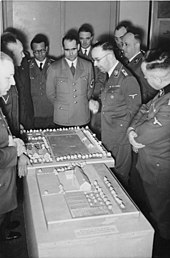 Policies regarding Poles, Russians, and other SlavsAs early as 1925, Hitler suggested in Mein Kampf that the German people needed Lebensraum ("living space") to achieve German expansion eastwards (Drang nach Osten) at the expense of the "inferior Slavs". Hitler believed that "the organization of a Russian state formation was not the result of the political abilities of the Slavs in Russia, but only a wonderful example of the state-forming efficacity of the German element in an inferior race."[64] After the invasion of the Soviet Union, Hitler expressed his future plans for the Slavs:
Nazi ideology viewed the Slavic peoples as non-Aryan Untermenschen ("sub-humans"), who were targeted for enslavement, expulsion and extermination.[17] The racial status of Slavs during the Third Reich was inconsistent over time.[66] Hitler viewed the Slavs as "a mass of born slaves who feel the need of a master".[67] Nazi propaganda portrayed the Germanic peoples as "heroes" in contrast to the Jewish and Slavic "sub-humans".[68] Nazi propaganda depicted Eastern Europe as racially mixed "Asiatic" that was dominated by the Jews with the aid of Bolshevism.[21] The Nazis considered some people in Eastern Europe to be suitable for Germanization (they were presumed to be of German descent); if they were considered racially valuable they were to be re-Germanized and forcefully taken from their families to Germany and raised as Germans.[18] The final version of Generalplan Ost, essentially a grand plan for ethnic cleansing, was divided into two parts: the Kleine Planung ("Small Plan"), which covered actions which were to be taken during the war, and the Grosse Planung ("Big Plan"), which covered actions to be undertaken after the war was won (to be carried into effect gradually over a period of 25–30 years). The Small Plan was to be put into practice as the Germans conquered the areas to the east of their pre-war borders. The individual stages of this plan would then be worked out in greater detail. In this way, the plan for Poland was drawn up at the end of November 1939. 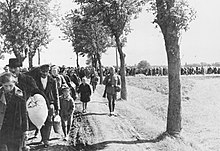 The plan envisaged removal of the majority of the population of conquered counties, with very small and varied percentages of the various conquered nations undergoing Germanisation, expulsion into the depths of Russia, and other fates, the net effect of which would be to ensure that the conquered territories would be Germanized.[17] Himmler declared during the Germanization process that no drop of German blood would be lost or left behind to mingle with any "alien races".[69] The Wehrbauer ("soldier-peasants") would settle in a fortified line to prevent civilization arising beyond and threatening Germany.[70] 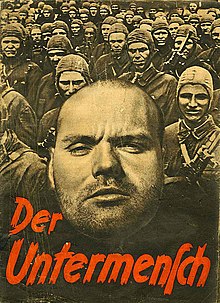 The Nazis issued the Polish decrees on 8 March 1940 which regulated the working and living conditions of Polish laborers (Zivilarbeiter) used during World War II in Germany. The decrees set out that any Pole "who has sexual relations with a German man or woman, or approaches them in any other improper manner, will be punished by death."[73] The Gestapo were extremely vigilant about sexual relations between Germans and Poles and pursued any case relentlessly where this was suspected.[74] There were similar regulations used against the other ethnic groups brought in from Eastern Europe, including the death penalty for sexual relations with a German person.[74] During the war, hundreds of Polish and Russian men were executed for their relations with German women.[75][76] Heinrich Himmler, in his secret memorandum "Reflections on the Treatment of Peoples of Alien Races in the East" dated 25 May 1940, expressed his own thoughts and the future plans for the populations in the East.[77] Himmler stated that it was in the German interest to discover as many ethnic groups in the East and splinter them as much as possible, find and select racially valuable children to be sent to Germany to assimilate them and restrict non-Germans in the General Government and conquered territories to four-grade elementary school which would only teach them how to write their own name, to count up to 500 and to obey Germans.[77] Himmler believed the Germanization process in Eastern Europe would be complete when "in the East dwell only men with truly German, Germanic blood".[78] After the launch of Operation Barbarossa in 1941, Nazi Germany officially described the military invasion as a "European crusade against Bolshevism" in the international arena. On the other hand, Nazi propaganda targeting domestic audiences vigorously depicted the war against Soviet Union as a racial struggle of Aryans against "Jewish and Slavic untermenschen" to annihilate "Judeo-Bolsheivism".[79] Reich Security Main Office (RSHM) proliferated conspiratorial, racist propaganda themes that identified "Jewishness with Bolshevism" and vilifiied Slavs as "untermenschen". These tropes were key elements of Nazi ideology and propaganda throughout World War II.[80] Other "non-Aryans" Though the laws primarily targeted Jews,[81] other "non-Aryan" people were subject to the laws, and to other legislation concerned with racial hygiene. The term "Aryan" was never fully defined—it was too imprecise and ambiguous; a number of judicial and executive decisions made attempts over time to clarify the concept. Outside of Europe, North African Arabs were by definition non-Aryan because of their "African origins", but according to Alfred Rosenberg's racial theories (The Myth of the Twentieth Century), some of the Berbers, particularly the Kabyles and the Rif, were to be classified as Aryans.[82] The Nazis portrayed Swedes, the Afrikaners – who are white European descendants of Dutch-speaking Boers in South Africa – and higher-degree Northern/Western Europeans of South America (mainly from Uruguay, Brazil and Argentina) as ideal "Aryans" along with the German-speaking peoples of Greater Germany and Switzerland (the country was neutral during the war). The Roma (Gypsies), who, while considered originally Aryan, were deemed a threat to the Aryan race because of their racial mingling.[83] IraniansBeginning in 1933, Nazi leadership made efforts to increase their influence in Iran, and they financed and managed a racist journal, Iran-e Bastan, co-edited by a pro-Nazi Iranian, Abdulrahman Saif Azad. This and other chauvinistic publications in the 1930s were popular among Iranian elites, as they "highlighted the past and the pre-Islamic glories of the Persian nation and blamed the supposedly 'savage Arabs and Turks' for the backwardness of Iran."[84] The Nazis advocated the common Aryan ancestry of Iranians and Germans. As a result, in 1936 the Reich Cabinet issued a special decree exempting Iranians from any restrictions to the Nuremberg Racial Laws on the grounds that they were "pure" Aryans. Various pro-Nazi publications, lectures, speeches, and ceremonies, also drew parallels between Reza Shah, Hitler, and Mussolini to emphasize the charismatic resemblance among these leaders.[84] Nazi ideology was most common among Persian officials, elites, and intellectuals, but "even some members of non-Persian groups were eager to identify themselves with the Nazis"[attribution needed] and a supposed Aryan race.[84] In 1934, the Nazis celebrated the Ferdowsi millennial celebration in Berlin, in which the Nazi government declared that the German and Persian people share membership in a common Indo-Germanic race. Hitler declared Iran to be an "Aryan country"; the changing of Persia's international name to Iran in 1935 was done by the Shah at the suggestion of the German ambassador to Iran as an act of "Aryan solidarity".[85] Also, Hitler personally promised that if he defeated the Soviet Union, he would return all of the Persian land taken by Russians during the Russo-Persian Wars. Even in 1939, Germany provided Iran with the so-called German Scientific Library. The library contained over 7,500 books selected "to convince Iranian readers... of the kinship between the National Socialist Reich and the Aryan culture of Iran".[86] In 1936, the Nazi Office of Racial Politics, in response to a question from the German Foreign Ministry, classified non-Jewish Turks as Europeans, but "left unanswered the question of how to think about the obviously non-European Arabs, Persians, and Muslims."[87] Later that year, ahead of the Summer Olympic Games in Berlin, the Nazis responded to questions from the Egyptians by saying that the Nuremberg racial laws did not apply to them, and after the Iranian ambassador to Berlin "assured German officials that 'there was no doubt that the Iranian, as an Aryan,' was 'racially kindred (artverwandt) with the Germans," the German Foreign Ministry "assured the Iranian Embassy in Berlin that the correct distinction between was not between "Aryans and non-Aryans" but rather between "persons of German and related blood on one hand and Jews as well as racially alien on the other."[87] Iranians were classified as "pure-blooded Aryans" and thus were excluded from the Nuremberg Laws.[84] Following the passage of the Nuremberg Laws in 1935, the Expert Advisor for Population and Racial Policy redefined "Aryan" as someone who is "tribally" related to "German blood".[88] Therefore, the official declaration by the Nazi state of Iranians being Aryans effectively rendered them as being "of kindred blood" to the Germans. Turks and TurkicsTurksIn 1935, a half-Turkish half-German man named "Johannes Ruppert" was forced to leave the Hitler Youth, due to the belief that as the son of a Turkish man he was not a full Aryan as required by the Reich Citizenship Law.[89] Ruppert sought assistance from the Turkish Embassy in Berlin to clarify how “the Aryan question” affected his case. The Turkish Embassy brought the matter to the attention of the German Foreign Ministry. In a note of December 20, 1935, a Foreign Ministry official wrote that "opening up the Aryan question in relation to Turkey is extraordinarily undesirable as well as dangerous for our relations with Turkey".[89] However, in January 1936, Foreign Ministry wrote a memo to the Nazi Party Office of Racial Policy, writing that it was "essential that determination of whether the Turks are Aryan be decided as soon as possible", so that the Foreign Ministry could give "a satisfactory answer" to the Turkish Embassy's repeated questions about the issue, since there had been individual cases, that is, others in addition to Ruppert, in which "German citizens with Turkish mixed-blood had run into difficulties with the state and the [Nazi] Party due to their origins".[89] The classification of Turks as "non-Aryans", in keeping with Nazi racial theories, led to foreign policy complications, because the Nazis considered the Turkish government as a potential ally. Consequently, the racial theories had to be "modified" to some degree in accordance with foreign policy requirements.[90] On April 30, 1936, Nazi Office for Racial Policy released a circular which stated that the Turks were "Europeans" while explaining that Turkish citizens of Jewish background would still be considered Jews and Turks of "colored origin" would be considered non-European.[91][89] Some Turkish and international newspapers, such as the Swiss Le Temps and the Turkish Republique, reported at the time that the Turks had been recognized as an "Aryan nation" and that they were exempt from the Nuremberg laws.[92][93] Turkish newspaper Akşam published an article with the headline "The Turks are Aryans!".[94] Such reports were picked up by other international newspapers, as well as by some modern scholarship, however the claim that the Turks had been recognized as an "Aryan nation" and that they were exempt from the Nuremberg laws was a hoax.[92][93] Nazi officials themselves disputed these reports by publishing a press release which stated that they were unfounded.[93] The Nazis classified some Turks as "European" and not as "Aryans" and the decision had no practical consequences.[92] In addition, this decision was designed to appease Turkey from a foreign policy standpoint, although, from a racial standpoint, Nazi officials did not believe that the Turks were neither European nor Aryan.[89] In May 1942, a writer in the official journal of the Nazi Office for Racial Policy, Neues Volk, replied to a father's question caused by his daughter's relationship with a Turkish man, about whether racial differences between Germans and Turks meant that a marriage should not take place.[89][95] The reply read:[89]
Although the Nazi leadership agreed with the content of the reply, they criticized the journal for publishing it, because, in a foreign policy point of view, it was really clumsy ("denkbar ungeschickt") to publish before defeating the British in Middle East.[89][95] For example, Franz von Papen, the German ambassador to Turkey, informed the German Foreign Ministry that the publication of this text "has serious foreign policy considerations". He noted that such statements could aid "our Anglo-Saxon opponents" in their "propaganda against us" and asked the Office of Racial Politics not to publish such things in the future.[89] On May 16, 1942, Franz Rademacher, director of the Office of Jewish Affairs in the German Foreign Ministry, wrote to Walter Gross, the founder and editor of the magazine, that he "had no objection to the content of the information from a racial-political viewpoint but that it was "from a foreign policy standpoint, really clumsy” and "a political blunder" that would have "embarrassing and awkward foreign policy implications".[89] Nazi officials sought to prevent miscegenation between Turks and Germans and, if necessary, sought to imprison or deport the "offending" Turkish man.[89] Crimean KaraitesThe Crimean Karaites, Turkic speakers following Karaite Judaism, managed to get a declaration from the Reich Agency for the Investigation of Families that they were not to be considered of Jewish religion and their racial classification should be done individually.[97] However, not every Nazi officer or soldier were aware of the official position and a small number Karaites were murdered by German troops in Russia, as if they were Jews. The majority of the Karaites fared much better than the Turkic-speaking Jews, the Krymchaks.[98] NorwegiansIn Norway, the Nazis favored and promoted children between Germans and Norwegians, in an attempt to raise the birth rate of Nordic Aryans. Around 10,000–12,000 war children (Krigsbarn) were born from these unions during the war. Some of them were separated from their mothers and cared for in so-called "Lebensborn" clinics ("Fountain of Life" clinics).[99][100] Finno-UgricsThe Finns had a debatable position in the Nazi racial policies, as they were considered a part of the "Eastern Mongol race" with the Sámi people in traditional racial hierarchies.[101][102] Finland did not have Lebensborn centres, unlike Norway, although Finland had tens of thousands of German soldiers in the country. Archival research however has found out that 26 Finnish women were in contact with the Lebensborn program for unspecified reasons.[103] In 1941 Nazi Germany established the Reichskommissariat Ostland to administer the conquered territories of the Baltic region. The colonial department in Berlin under Minister Alfred Rosenberg (born in Tallinn in 1893) looked on Estonians favorably as Finno-Ugrics and thus as "Aryans", Generalkommissar Karl-Siegmund Litzmann authorized a Landeseigene Verwaltung, or local national administration.[104] As Germany invaded the Soviet Union in June 1941, Finland participated in the invasion primarily to recover the territories it was forced to cede to the USSR after the Moscow Peace Treaty which ended the Winter War between the Finns and the Soviets. Owing to Finland's substantial military contribution on the northern flank of the Eastern Front of World War II, Hitler decreed in November 1942 that "from now on Finland and the Finnish people be treated and designated as a Nordic state and a Nordic people", which he considered one of the highest compliments that the Nazi government could bestow upon another country.[105] Hitler stated in private conversation that:
East Asians   In Mein Kampf, Hitler expressed his praise for the Japanese's acceptance of European civilization and his rejection of the assimilation of Chinese into Germany:
The need to maintain working relations with Japan and China forced the Nazis to back off from some of their previous racial rhetoric. In his "Political Testament" of 1945, Hitler claimed that "I have never regarded the Chinese or the Japanese as being inferior to ourselves. They belong to ancient civilisations, and I admit freely that their past history is superior to our own. They have the right to be proud of their past, just as we have the right to be proud of the civilisation to which we belong."[108] Since 1926, Germany had supported the Republic of China militarily and industrially. Germany had also sent advisers such as Alexander von Falkenhausen and Hans von Seeckt to assist the Chinese, most notably in the Chinese Civil War and China's anti-communist campaigns. Max Bauer was sent to China and served as one of Chiang Kai-shek's advisers. Around this time, Hsiang-hsi Kung, the Republic of China Minister of Finance, visited Nazi Germany and was warmly welcomed by Hitler on June 13, 1937. During this meeting, Hitler, Hermann Göring, and Hjalmar Schacht bestowed upon Kung an honorary doctorate degree, and attempted to open China's market to German exports. In order to attract more Chinese students to study in Germany, Hitler, Göring, and Schacht earmarked for 100,000 reichsmarks for Chinese students studying in the universities and military academies of Nazi Germany after they persuaded a German industrialist to set aside the money for that purpose. Moreover, Kung, in favor of commercial credits, politely refused a generous international loan offer by Adolf Hitler.[109] The most famous of these Nazi-trained Chinese officers was Chiang Wei-kuo, the son of Republic of China President Chiang Kai-shek, who studied military strategy and tactics at a Kriegsschule in Munich, and subsequently achieved the rank of lieutenant and served as an officer in the Wehrmacht on active combat duty in Europe until his return to the Republic of China during the later years of World War II.[110][111][112][113][114] In fact, in the early days, the Nazis did not persecute the Chinese and allowed the Chinese to go to Germany to study or become military officers. This was because China did not become a warring country with Germany, and the countries still maintained normal exchanges, and the two sides had trade and military cooperation. And Germany can obtain cheap raw materials from China. However, during World War II, after China joined the Allies, Nazi Germany also oppressed and harmed the Chinese living in Germany. The Gestapo launched the Chinesenaktion (China action) on May 13, 1944. 129 Chinese citizens were arrested, of which at least 17 Chinese died from Gestapo shooting or forced labor. Due to Nazi Germany's recognition of Japanese as "Aryans of the East"[114] Hitler had allowed Japanese soldiers to study in Nazi German military academies and serve in the Nazi German Wehrmacht as part of their combat training. Hitler had supported the Empire of Japan as early as 1904, when during the Russo-Japanese War it had defeated the Russians, which he considered a defeat for Austro-Slavism.[115][116] He made a number of other statements expressing his respect and admiration for the Japanese in his book Mein Kampf.[117][118] Although of a separate and different evolutionary race, the Imperial Japanese were considered by Nazi ideologists such as Himmler as having sufficiently superior qualities as did German-Nordic blood to warrant an alliance. Himmler, who possessed a great interest in, and was influenced by, the anthropology, philosophies and pantheistic religions of East Asia, mentioned how his friend Hiroshi Ōshima, the Japanese Ambassador to Germany, believed that the noble castes in Japan, the daimyo and the samurai, were descended from gods of celestial origin, which was similar to Himmler's own belief that "the Nordic race did not evolve, but came directly down from heaven to settle on the Atlantic continent."[119] Initially, the Japanese were still subject to Germany's racial laws, which – with the exception of the 1935 Nuremberg Laws that specifically mentioned Jews – generally applied to all "non-Aryans". However, since Japanese were given "Aryans of the East" status, these racial laws were applied to them in a lenient manner as compared to other "non-Aryans" who were not granted "Aryan" status by Adolf Hitler. The Nazi German government began enacting the laws after taking power in 1933, and the Japanese government initially protested several racial incidents involving Japanese or Japanese-Germans that year which were then resolved by the Nazi high command by treating their Japanese allies leniently in these disputes. Especially after the collapse of Sino-German cooperation and Chinese declaration of war on Germany, Chinese nationals faced prosecution in Germany. Influential Nazi anti-Semite Johann von Leers favored excluding Japanese from the laws due both to the alleged Japanese-Aryan racial link and to improve diplomatic relations with Japan. The Foreign Ministry agreed with von Leers and sought several times between 1934 and 1937 to change the laws, but other government agencies, including the Racial Policy Office, opposed the change.[120] Then in October 1933, German Foreign Minister Konstantin von Neurath issued an exemption to and Japanese from the racial laws. Additionally, in April 1935 another Nazi decree stated that racial discrimination cases involving Aryans of the East (aka. Japanese) that might jeopardize German diplomatic relations—i.e., Japanese—would be dealt with individually. Decisions on some cases sometimes took years, with those affected unable to obtain jobs or interracially marry, primarily because the German government preferred as much as possible to avoid giving exemptions. The German government often exempted more German-Japanese than it preferred in order to avoid a repeat of the 1933 controversies, and in 1934 it prohibited the German press from discussing the race laws when Japanese were involved to avoid any diplomatic problems with China or Japan.[120] Germanization between 1939 and 1945Nazi policy stressed the superiority of the Nordic race, a sub-race of the white European population defined by the measurement of the size and proportions of the human body models of racial difference.[121] From 1940 the Nazi authorities in the General Government (occupied Poland) divided the population into different groups.[69] Each group had different rights, food rations, allowed strips in the cities, separated residential areas, special schooling systems, public transportation and restricted restaurants. Later adapted in all Nazi-occupied countries by 1942, the Germanization program used the racial caste system of reserving certain rights to one group and barred privileges to another. Ethnic Poles were believed by Hitler to be "biologically inferior race" that could never be educated or elevated through Germanization.[122] In 1940, Hitler approved of a plan regarding the Germanization of the Protectorate of Bohemia and Moravia, he estimated around half of the Czech population were suitable for Germanization but made clear that the "mongoloid" types and Czech intelligentsia were not allowed to be Germanized.[123] During the occupation of Poland, the Nazi government kidnapped children with Nordic racial characteristics. Those classified as "racially valuable" were sent from to the German Reich to be adopted and raised as Germans, while those who failed the tests would be used in slave labor or murdered in medical experiments.[124] Nordicist anthropometrics was used to "improve" the racial make-up of the Germanized section of the population, by absorbing individuals into the German population who were deemed suitably Nordic.[17] Germanization also affected the Sorbs, the minority Slav community living in Saxony and Brandenburg, whose Slavic culture and language was suppressed to absorb them into German identity.[125] Tens of thousands suffered internment and imprisonment as well, to become lesser-known victims of Nazi racial laws.[126] Similarly, the Nazis considered the people living in the Goralenvolk area to be descended from ethnic Germans and were therefore classified as Aryans.[127] See also
References
Bibliography
Further reading
External links
|

